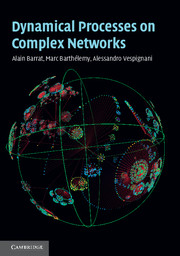Book contents
- Frontmatter
- Contents
- Preface
- Acknowledgements
- List of abbreviations
- 1 Preliminaries: networks and graphs
- 2 Networks and complexity
- 3 Network models
- 4 Introduction to dynamical processes: theory and simulation
- 5 Phase transitions on complex networks
- 6 Resilience and robustness of networks
- 7 Synchronization phenomena in networks
- 8 Walking and searching on networks
- 9 Epidemic spreading in population networks
- 10 Social networks and collective behavior
- 11 Traffic on complex networks
- 12 Networks in biology: from the cell to ecosystems
- 13 Postface: critically examining complex networks science
- Appendix 1 Random graphs
- Appendix 2 Generating functions formalism
- Appendix 3 Percolation in directed networks
- Appendix 4 Laplacian matrix of a graph
- Appendix 5 Return probability and spectral density
- References
- Index
1 - Preliminaries: networks and graphs
Published online by Cambridge University Press: 05 September 2012
- Frontmatter
- Contents
- Preface
- Acknowledgements
- List of abbreviations
- 1 Preliminaries: networks and graphs
- 2 Networks and complexity
- 3 Network models
- 4 Introduction to dynamical processes: theory and simulation
- 5 Phase transitions on complex networks
- 6 Resilience and robustness of networks
- 7 Synchronization phenomena in networks
- 8 Walking and searching on networks
- 9 Epidemic spreading in population networks
- 10 Social networks and collective behavior
- 11 Traffic on complex networks
- 12 Networks in biology: from the cell to ecosystems
- 13 Postface: critically examining complex networks science
- Appendix 1 Random graphs
- Appendix 2 Generating functions formalism
- Appendix 3 Percolation in directed networks
- Appendix 4 Laplacian matrix of a graph
- Appendix 5 Return probability and spectral density
- References
- Index
Summary
In this chapter we introduce the reader to the basic definitions of network and graph theory. We define metrics such as the shortest path length, the clustering coefficient, and the degree distribution, which provide a basic characterization of network systems. The large size of many networks makes statistical analysis the proper tool for a useful mathematical characterization of these systems. We therefore describe the many statistical quantities characterizing the structural and hierarchical ordering of networks including multipoint degree correlation functions, clustering spectrum, and several other local and non-local quantities, hierarchical measures and weighted properties.
This chapter will give the reader a crash course on the basic notions of network analysis which are prerequisites for understanding later chapters of the book. Needless to say the expert reader can freely skip this chapter and use it later as a reference if needed.
What is a network?
In very general terms a network is any system that admits an abstract mathematical representation as a graph whose nodes (vertices) identify the elements of the system and in which the set of connecting links (edges) represent the presence of a relation or interaction among those elements. Clearly such a high level of abstraction generally applies to a wide array of systems. In this sense, networks provide a theoretical framework that allows a convenient conceptual representation of interrelations in complex systems where the system level characterization implies the mapping of interactions among a large number of individuals.
- Type
- Chapter
- Information
- Dynamical Processes on Complex Networks , pp. 1 - 23Publisher: Cambridge University PressPrint publication year: 2008
- 3
- Cited by



